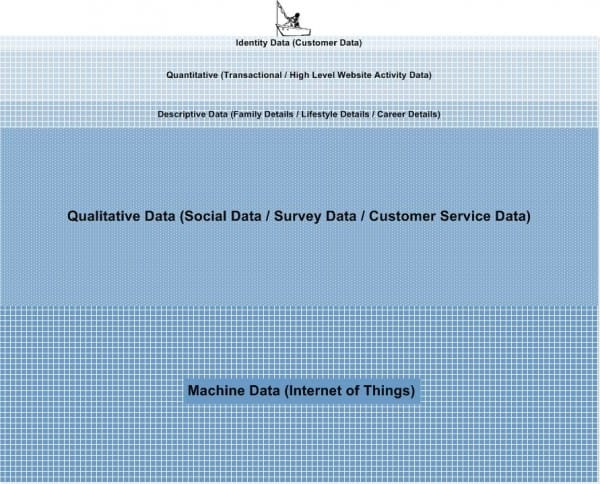Continuing our briefing on how to apply Big Data for Marketing

In the first post in this short series I gave an introduction to using Big Data for marketing. That introductory post included an overview of the concept and looked at the three core elements Volume, Velocity and Variety.
In this second post in the series, I will look at the impact of the increase volumes of data associated with Big Data - what does this mean in practice for real-world marketing?
Of the 3 V’s, Volume is the easiest to relate to Big Data, as it is about the amount of data, which as of 2012 stood at ~2.5 zettabytes and is expected to grow to almost 7.9 zettabytes by 2015. It is however a controversial area with many differing opinions on what constitutes ‘big volume’. To my 5 year old son I am a giant and whilst not short at just over 6ft I am by no means a giant... This differing perception of what constitutes high volume changes from industry to industry meaning that the physical size of the data is not necessarily relevant but the ability to manage and use high volumes of data in your business is the critical element. So, if we look at small to medium-sized businesses (SMEs) what does this volume element of Big Data consist of in terms of types of data?
Well let’s first consider data we already have and see if this is impacted by ‘big volume’
- Identity data? (see Is knowing my Pet's Name Valuable?) - This type of data helps to uniquely identify the individual customer or prospect, and whilst impacted by the multiple channels a customer can now interact through is not a major cause of increased data volume for identity data in most SMEs when considering Big Data.
- Quantitative data? - Information on the customer’s direct activity with your business through purchase history, communication history (inbound and outbound), high level website activity from web analytics (visit history, product views, etc), social direct interaction (Facebook likes) are all available currently, and in most cases able to be integrated into the existing view of a customer and their activity. So again at the top direct interaction level this is not a cause of increased data volume for most SMEs.
- Descriptive data? - Additional profile information of your customers, helps provide a fuller picture of who they are and their current life stage. This includes data such as family details (marital status, number of children, etc.), lifestyle details (property type, car type, etc.) and career details (profession, education level, etc.) This information whilst not always available, is achievable through third party data or additional data capture initiatives, which although adding to the size of your data is not of the scale of Big Data.

These first three types of data are well established and used within many businesses, although not always in a combined customer view. This type of data is held in a structured, accessible and usable fashion, allowing existing tools to analyse and use the data to deliver actionable insight. With Big Data, the majority of new information will come from the next tiers of data:
- Qualitative data - This type of data further defines potential customer behaviour and covers attitudinal information, opinion and motivational indicators. Some of this will exist in structured survey type information, but most will be part of unstructured social data, email conversations and free format customer service text. This type of data, particularly social is growing at a phenomenal rate, with on average nearly 6,000 tweets per second being generated according to Twitter as of August 2013.
- Machine data - The increased connectivity of all things (Internet of Things) is seeing the generation of vast amounts of additional data as various devices, apps, etc. store and record details of all activity at a granular level.

So looking at these two final types of data what value could they drive?
1) Improved Customer Engagement
Through the use of Social Commentary or Social Listening it is possible to gain a better understanding of your customers view / perception, which is not always possible through the standard layers of data and not always forthcoming from customer surveys. This provides a pulse of current and historic customer’s opinion/sentiment allowing you to better understand and therefore improve engagement with your customer.
To achieve this will require the analysis of unstructured data to gain a view on key phrases, with a common example seen in Word Clouds a simple way to see the most common words in a body of text. This can be seen below in an analysis of a major cruise company’s website to see the key messages presented:

This is a simplistic approach and does not provide correlations or context between words, which using alongside other techniques will provide understanding and meaning to customers conversations.
2) Greater Understanding
With more depth and breadth of data the ability to create statistically significant models of low occurring but highly predictive factors becomes possible. With data being able to be segmented into smaller groups of customers to drive true 1-2-1 conversations based on recent and historic information. Think of location information provided through smart phones and app usage providing a history of when and where customers engage, which will then enable the ability to target customers based on standard and abnormal activity.
With Machine data this goes further as you will start to see information that can predict future events before the customer realises. For example, if data collected by components of your customer’s car were collected and made available, it is not impossible to see a situation where you could inform the customer of a potential issue before they realised based on changes in information captured. Alternatively the change of usage of a product could indicate a change in circumstance, change in ownership or potential future churn of that customer to a newer product.
3) Purchaser versus Consumer
Not all products purchased are used by the purchaser, seems like a fairly obvious comment. With traditional data the purchaser is the customer and this is who you talk to, however with the introduction of machine and social data it provides the ability to further identify three key groups:
- Purchasers who use the product.
- Purchaser who buy the product as a gift.
- The consumer who has not purchased the product but is the active user.
A good example of this is LEGO, where the consumers of the product are mostly children, but the initial main purchasers are parents and grandparents. Through survey type information and initiatives such as LEGO Club Membership and LEGO Digital Designer it is possible to build the relationship with the actual consumer (user), but this relies on active engagement from the child to your products. As a child I wanted to just play with the toy and then would probably tell friends in the playground, in today’s age the playground chat has gone digital with social media being a key part of that interaction. This provides LEGO with the potential to understand usage of their products through direct interactions and social engagement, driving improved and personalised communications to both the purchaser and consumer. Interestingly LEGO created a child friendly social network called My LEGO specifically aimed at children to bring this interaction into a full LEGO experience and not through 3rd party social media sites.
In this first of three posts looking at the value to Marketing of the 3 V’s of Big Data I have reviewed how increased data Volume provides breadth and depth to your understanding of your customers. In the next posting I will look at the impact of Velocity.










